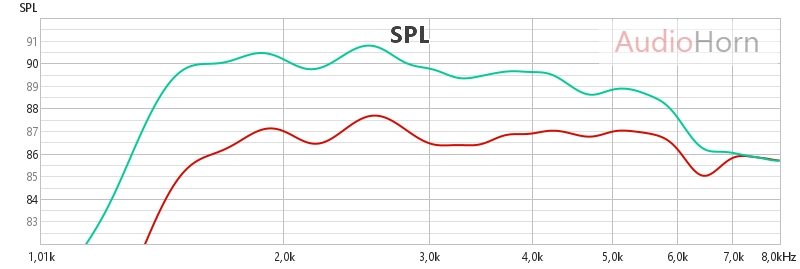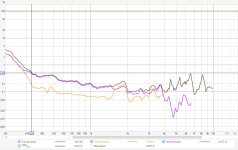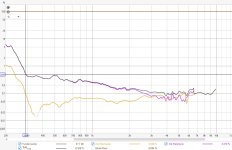Really? So it is not disingenuous to state 290Hz loading/cutoff with 33cm effective horn length?That's a bit disingenuous
I encourage all to show the normalized distortion figures for the combos discussed down to at least 300Hz.
^^ Although x deep horn in infinite baffle approaches definition of flat in relative terms, it's not for sound since sound has size defined to it. Everything is relative to wavelength, that's why certain size and shape object has certain properties at certain frequency. Wavelength is physical size of sound.
If any property, like loading/cutoff or features in directivity, needs to move lower in frequency, the object size needs to get bigger. And if features need to move up in frequency, the object needs to get smaller. IOW shrink physical size of an object and features in it's response all move up in frequency, enlarge the object and everything moves down in frequency.
For example, one could take any horn profile and just scale it bigger to move cutoff lower in frequency (and directivity, and all properties of its response). Problem is, your driver throat size is static, so the profile can't just scale as the throat entry would get bigger than the driver's, so the profile needs to be adjusted. Anyway, hopefully this helps to think through some of the stuff.
ps. Mabat has demonstrated in ATH thread that one can take good waveguide profile and just extend it with a tubular section to change loading, independently from directivity. So, not sure whats the fuzz, everyone could go and start optimizing a horn or waveguide exactly to their own spec. Spec might be unobtainable in reality, and there is no better way to learn it than iterating profiles in simulator for few weeks.
If any property, like loading/cutoff or features in directivity, needs to move lower in frequency, the object size needs to get bigger. And if features need to move up in frequency, the object needs to get smaller. IOW shrink physical size of an object and features in it's response all move up in frequency, enlarge the object and everything moves down in frequency.
For example, one could take any horn profile and just scale it bigger to move cutoff lower in frequency (and directivity, and all properties of its response). Problem is, your driver throat size is static, so the profile can't just scale as the throat entry would get bigger than the driver's, so the profile needs to be adjusted. Anyway, hopefully this helps to think through some of the stuff.
ps. Mabat has demonstrated in ATH thread that one can take good waveguide profile and just extend it with a tubular section to change loading, independently from directivity. So, not sure whats the fuzz, everyone could go and start optimizing a horn or waveguide exactly to their own spec. Spec might be unobtainable in reality, and there is no better way to learn it than iterating profiles in simulator for few weeks.
Last edited:
Btw, horn length cannot be replaced with anything else imo.If you want to say that the mouth area is the determining factor then simply use a zero length horn and a round shim with this area. How much loading you have?
Yes but talking only about deep is over simplified :
https://audiohorn.net/sciences/horn-acoustic-loading/
- Impact Loading: The closer and smaller the air surface near a horn’s throat, the greater the impact loading.
- Directivity Control: Loading cannot be “sent” beyond the horn’s directivity control end; this would be ineffective. Horns exhibiting good loading effects often have a strong cutoff approaching the horn’s control end, due to this effect, allowing for a lower crossover frequency that can be defined by Group Delay, in addition to directivity matching and driver distortion.
This interplay between directivity and loading can also result in a “bell response” due to the interplay of constant directivity and loading.
- Loading and Frequency: Loading effect decreases with increasing frequency. Consequently, the “anchor point” (14/15kHz) SPL, used for our horn EQ, remains unaffected by loading but will be influenced by directivity, as discussed in the next point.
- Off-Axis Energy: At a given frequency, energy present off-axis is no more present on-axis. This is one of the reasons why pursuing constant directivity up to 20kHz is not necessary, especially when considering audibility and psychoacoustics.
- Loading Uniformity: Loading is not uniform at all. The characteristics mentioned above define a frequency range of loading effects, with a given dB pressure level, forming a curve that will interact with driver one. Surface area size, expansion, and directivity significantly influence these effects.
- Example of Loading Effect: Lengthening the horn throat can significantly alter loading. However, these manipulations must be approached cautiously as they impact wavefront propagation and, consequently, directivity. This is why FEA simulations are essential for accurate predictions.

It's exactly what I do with X-Shape, you can look the X-Shape profile and the SPL response on the website, it's uplifting in this case :
https://audiohorn.net/x-shape-horn/
Hi NicoB, on the x shape page you linked, the polar plots and frequency responses are really nice and show no hint of edge diffraction, but I'm suspicious as there is no roundover on the device images so there should be plenty, almost for the whole bandwidth as they are constant directivity. Are they infinite baffle measurements or sims?
Could you please link it if you have it handy? I remember reading it myself, but probably was completely floored by Mabats switch from waveguides to horns after claiming for so long that loading was pointless.Mabat has demonstrated in ATH thread that one can take good waveguide profile and just extend it with a tubular section to change loading, independently from directivity
I am imagining basically a constant CSA line before expansion... a TL
Last edited:
Hi they are measured like this with provided FEA return when asked so in real condition :Hi NicoB, on the x shape page you linked, the polar plots and frequency responses are really nice and show no hint of edge diffraction, but I'm suspicious as there is no roundover on the device images so there should be plenty, almost for the whole bandwidth as they are constant directivity. Are they infinite baffle measurements or sims?
https://audiohorn.net/img/X-Shape/x-shape-return-kit.jpg
You can find full integration on this group: https://www.facebook.com/groups/959601695539573
Not sure there was a paper yet, no mark in memory, but my memory doesn't hold as well as it used to 🙂Could you please link it if you have it handy? I remember reading it myself, but probably was completely floored by Mabats switch from waveguides to horns after claiming for so long that loading was pointless.
I am imagining basically a constant CSA line before expansion... a TL
See these, and before/after, tons of measurements and sims with and without throat extension.
Here's the influence of adding various lengths of a straight duct segment to a 1" throat, zero exit angle.
Obviously, as a result, it 1) increases efficiency at LF, 2) decreases efficiency in the middle of the passband, 3) adds some FR ripple, not nearly as pronounced with the real devices, however - this can be vital. Note the directivity remains virtually unchanged.
Effects 1 and 2 together cause the driver's response to become more extended and flat - that's the only explanation I have. Perhaps different drivers require different lenghts of the extension. Anyway, starting the duct...
Obviously, as a result, it 1) increases efficiency at LF, 2) decreases efficiency in the middle of the passband, 3) adds some FR ripple, not nearly as pronounced with the real devices, however - this can be vital. Note the directivity remains virtually unchanged.
Effects 1 and 2 together cause the driver's response to become more extended and flat - that's the only explanation I have. Perhaps different drivers require different lenghts of the extension. Anyway, starting the duct...
The effect of the extended throat with NDX595 (the off-axis angles won't match precisely):

Search the thread with "25-EXT-1" to find most of it.
I have not simplified it to only length. Please read my posts carefully. ;-) I have exaggerated the importance of horn length.Yes but talking only about deep is over simplified :
https://audiohorn.net/sciences/horn-acoustic-loading/
It's exactly what I do with X-Shape, you can look the X-Shape profile and the SPL response on the website, it's uplifting in this case :
https://audiohorn.net/x-shape-horn/
If anyone is willing to show their data of distortion down to the lowest possible range of the horns pass-band. Here are two measurements for JBL2451 and DAS ND-10 in my 300Hz horn:
JBL2451:

DAS ND-10:

You see that I created a true 300Hz horn. There is knee when things become worse and where the driver should be out of the game.
Just show us the data with your short horn with the JBL2450SL.
Btw, what we have never seen is a picture of your throat section and the bunch of fins are arranged, and the adapter looks like. Have you used a radial arrangement?Hi they are measured like this with provided FEA return when asked so in real condition :
https://audiohorn.net/img/X-Shape/x-shape-return-kit.jpg
You can find full integration on this group: https://www.facebook.com/groups/959601695539573
If anyone is willing to show their data of distortion down to the lowest possible range of the horns pass-band.
I don't show everything and I still have to finish the mk2, you mean a fins radial arrangement centered on Apex ? YesBtw, what we have never seen is a picture of your throat section and the bunch of fins are arranged, and the adapter looks like. Have you used a radial arrangement?
fins works close to phase plug, equal paths to be in phase at fins exit, but if you mean that apex is not the emitting point of sound source (in this case) you right, Kolbrek book again also 😀
It is not necessary that you point me to Kolbrek/Dunker's book, as I studied it in detail a longer time ago and some things leaded to the mk3b2 horn.
The problem with ALL fin horns (including yours) is that you never know the apex of the driver's wave front at fin start. Even my coherent horn which seems to be beyond your design (and I discussed this bilaterally with Bjorn) will always have the issue that you do not know the start apex. So all fin horns will always be a compromise wrt this.
In a compression driver's phase plug, you know the entry apex very well so it can be designed properly.
Personally, I came to the conclusion that in a normal listening environment, a horn without fins is better than a horn with fins.
As you do not want to disclose your arrangement, how should a potential customer be able to assess what is going on in your design?
The problem with ALL fin horns (including yours) is that you never know the apex of the driver's wave front at fin start. Even my coherent horn which seems to be beyond your design (and I discussed this bilaterally with Bjorn) will always have the issue that you do not know the start apex. So all fin horns will always be a compromise wrt this.
In a compression driver's phase plug, you know the entry apex very well so it can be designed properly.
Personally, I came to the conclusion that in a normal listening environment, a horn without fins is better than a horn with fins.
As you do not want to disclose your arrangement, how should a potential customer be able to assess what is going on in your design?
I working in pro FEA on supercomputer, of course I know where it is... my specialty in audio is wavefront propagation and his behavior.
And I made phase plug too so...
The only things I show/will show is the external as on my website.
Bi-radial horns are just narrower vertically when X-Shape is at 60° constant vertically, so it's a different type of listening, there is also a different way to distribute energy, inside the +/- 6dB, energy is stage a little bit differently with fins (with no accidents in my design).
Usually I said if you listen some time sit down and sometime you move and your are stand up making other things, take X-Shape, otherwise the bi-radial is interesting too, but it's not related to fins at all, it's related to vertical directivity.
But I don't said it's the better horn, I have a client at the US (New York) that have bought one pair of X-Shape X41 and one of bi-radial mk2, for the pleasure to test , with 18Sound ND3, 18Sound 15NTLW3500 as woofer bellow and 18NLS4000 as subs, Hypex Ncore Amp and miniDSP Flex HTX as DSP/pre-amp.
, with 18Sound ND3, 18Sound 15NTLW3500 as woofer bellow and 18NLS4000 as subs, Hypex Ncore Amp and miniDSP Flex HTX as DSP/pre-amp.
And I made phase plug too so...
The only things I show/will show is the external as on my website.
Bi-radial horns are just narrower vertically when X-Shape is at 60° constant vertically, so it's a different type of listening, there is also a different way to distribute energy, inside the +/- 6dB, energy is stage a little bit differently with fins (with no accidents in my design).
Usually I said if you listen some time sit down and sometime you move and your are stand up making other things, take X-Shape, otherwise the bi-radial is interesting too, but it's not related to fins at all, it's related to vertical directivity.
But I don't said it's the better horn, I have a client at the US (New York) that have bought one pair of X-Shape X41 and one of bi-radial mk2, for the pleasure to test
 , with 18Sound ND3, 18Sound 15NTLW3500 as woofer bellow and 18NLS4000 as subs, Hypex Ncore Amp and miniDSP Flex HTX as DSP/pre-amp.
, with 18Sound ND3, 18Sound 15NTLW3500 as woofer bellow and 18NLS4000 as subs, Hypex Ncore Amp and miniDSP Flex HTX as DSP/pre-amp.But only for one specific driver and not for allof course I know where it is...

no, for all, compression driver act as a plane wave radiation device (purpose of phase plug) except at their break-up so very high.
If they don't, it can happens if diaphragm is not well tuned laterally or in height by factory or the guy that have replace it, then don't bought it lol.
If they don't, it can happens if diaphragm is not well tuned laterally or in height by factory or the guy that have replace it, then don't bought it lol.
Including these horns with less than ideal DI plots?So all fin horns will always be a compromise wrt this....... Personally, I came to the conclusion that in a normal listening environment, a horn without fins is better than a horn with fins.
https://cdn.shopify.com/s/files/1/0...ot_2023-10-14_170306_480x480.png?v=1697317415
https://cdn.shopify.com/s/files/1/0...BMS_4591-8_off-axis3_480x480.png?v=1649504045
Don’t know if size of ES290 horn would be too big to sit safely atop the Altec 416 woofer cabinets. They were $1800.00 for Jim Salk to build for me nine years ago; probably way too costly to scrap to build larger ones today. Will have to check with Troy about this horn/cabinet sizing.Also: Troy's horns are excellent, imho.
But, the ES450 is ACOUSTICALLY too small to be crossed over at 500 or even 600 Hz without issues (800 or 900Hz is more like it).
The ES290 is required if you target such a low crossover point.
A big part of the reason why Troy's horns are PHYSICALLY so large (compared to others with a similar cutoff) is that they sport a full mouth roll-back, to address and minimise edge diffraction. That is a good thing, but it makes, e.g., an ES290 significantly larger than an Arai A290, even though both are acoustically pretty much the same.
But whichever horn Troy says is safe to use would the Radian745Be perform just as well as the JBL 2450Be?
The ESxxx devices belong to a complete different class of horns than discussed in this thread (clones of TAD and Yuichi). The ESxxx have almost nothing in common with the fin horns discussed here. So you have to ask the vendor.
- Home
- Loudspeakers
- Multi-Way
- Looking at Yuichi A-290 or TAD TH-4001 Clones: Makers
